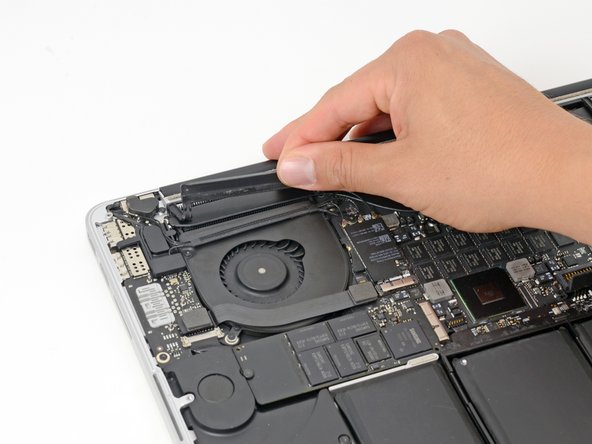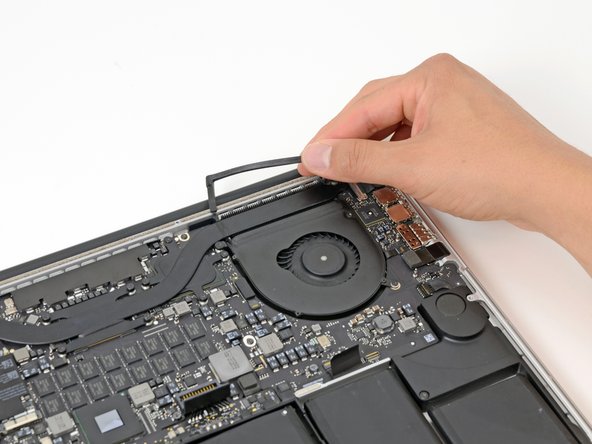Cette version peut contenir des modifications incorrectes. Passez au dernier aperçu vérifié.
Ce dont vous avez besoin
-
-
Dévissez les vis Pentalobe P5 suivantes fixant le boîtier inférieur au MacBook Pro :
-
Huit vis de 3,0 mm
-
Deux vis de 2,3 mm
-
-
-
Tirez vers l'arrière l'autocollant d'avertissement qui recouvre le connecteur de batterie.
-
-
-
-
Avec l'extrémité plate d'une spatule (spudger), soulevez délicatement le connecteur de batterie vers le haut hors de sa prise sur la carte mère.
-
Repliez les câbles de la batterie vers l'arrière et de côté afin que le connecteur de batterie ne touche pas accidentellement la carte mère.
-
-
Cette étape n’est pas traduite. Aidez à la traduire
-
Insert the flat end of a spudger underneath the rubber heat sink cover on the right fan.
-
Slide the spudger underneath the length of the cover, releasing the adhesive.
-
Lift the cover and rotate it off of the heat sink.
-
-
Cette étape n’est pas traduite. Aidez à la traduire
-
In the same manner described above, release the adhesive and flip back the heat sink cover on the left fan.
-
-
Cette étape n’est pas traduite. Aidez à la traduire
-
Remove the following six screws securing the heat sink to the logic board:
-
One 5.5 mm silver raised head T5 Torx screw
-
Four 3.5 mm T5 Torx screws
-
One 3.8 mm silver T5 Torx screw
-
-
Cette étape n’est pas traduite. Aidez à la traduire
-
Grasping the heat sink from one side, lift the heat sink off of the MacBook Pro, pulling it free from the computer.
-
Annulation : je n'ai pas terminé ce tutoriel.
31 autres ont terminé cette réparation.
12 commentaires
Performed today on 3 yrs old Retina 15" with integrated Iris Pro 5200. Temperatures dropped considerably, both during idle and load periods, but BE AWARE, if you pass control to the fans via i.e.: smsFanControl, during testing laptop reaches abnoxious temperatures (98C) - what it seems is that when smcFanControl is taking over, also throttling is turned off, therefore, when temperature rised you need to rise fan rpm (during Geekbench 3 I set it at the end to the 3800rpm from 2500rpm it was and this dropped immediately from 98C to 70C). When SmcFanControl is set to Default, MAC UEFI controls fans and - what is funny - when load exceeded reasonable thresholds, (one core reached 92C) it throttled (probably) because without much rpm raise - this dropped temps to 75C (Default setting did at critical point two things: a) from 2160 rpm to 2890rpm and b) throttle ... what ended in immediate drop to 75C). Keep that in mind.
In this aspect I consider this as a smarter management.
One of the screw thread used to tighten the spring-clamp holding the cpu in place has detached from the motherboard. Is it possible to repair this, and if not, is it fine to hold the cpu with only one spring clamp ? Thanks a lot !
Hopefully you are still around the forums these days.
You usually can fix something like that if it was soldered to the board, with simple solder and something to hold it in place. However if it was riveted to the board you may have another problem, of which I do not know how to solve. You happen to have a picture?
The image in Step 7, and the offered replacement part are wrong! In all images except step 7 you are showing the correct hardware, whitha heat pipe including cpu and discrete graphics plates. But in step 7, and in the replacement part offering you show a heat pipe containing only one plate! Please correct this? Where do I get a replacement heat pipe for my macbook containing adiscrete graphics chip? Thank you very much!
I want to know this as well. That said, I don’t really see the need to replace the heat sink. What’s the problem is that the thermal paste has dried up and no longer conducts as it used to. So simply removing the old heat sink, scraping off the paste and re-applying new paste should do the job just fine. I don’t see in what way the heatsink itself should go ‘bad’.














